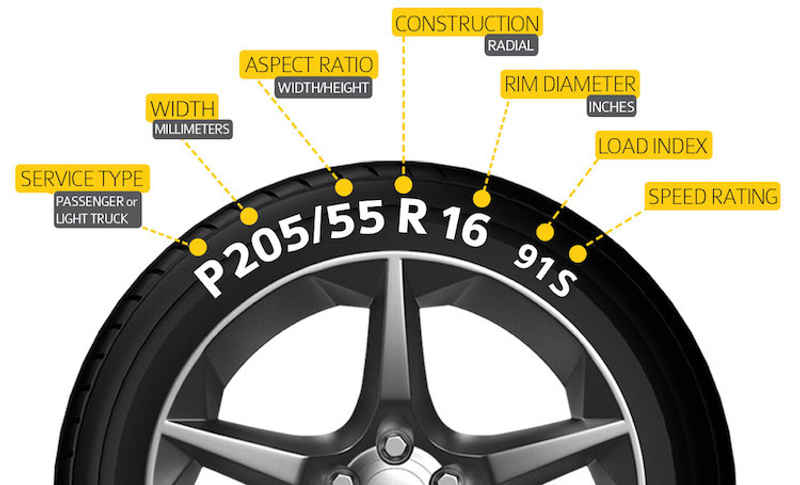The speed ratings of tyres indicate the maximum speed at which a tyre can maintain its desired performance while carrying a particular load for an ideal period of time. Desired performance here refers to providing proper grip or traction and stability to the vehicle. It is also indicative of the maximum heat it can handle.

However, it is important to note that these speed ratings are calculated in controlled conditions in a lab and only on new tyres. The actual real world speed rating of your tyre might reduce with age and is also dependent on other conditions like inflation level, vehicle load, road surface as well as weather conditions. Under adverse weather conditions or unfit surfaces, the speed rating will definitely be a lot lesser than what is described by the companies. Please note there is a difference between speed limit and speed rating. Speed ratings are not ideal driving speeds and will almost always be greater than the "speed limit".
HOW TO FIND YOUR TYRE SPEED RATING
The speed ratings of your tyres are pretty easy to find. The information is available at the following places :
- Owner's manual.
- driver's side door jamb,
- the gas tank hatch, or
- inside the glove box door
- sidewalls of your tyres
The speed rating is commonly the last character in the tyre code or sequence. It comes after the Load index. For example, if the tyre code/sequence is "205/55 R16 91S" then "S" is the speed rating of the vehicle. This means that the maximum recommended speed for the vehicle under ideal conditions would be 112 mph or 180 kmph.
How is it determined?
The speed rating of a tyre is determined in a laboratory under simulated conditions. It is important to note that no matter how well simulated the conditions are, they can never compare to real-life conditions. So you should always take the speed rating with a pinch of salt. Always consider other factors like the age of your tyres, tread wear, weather etc to decide which speed will be safe enough for your car.
Also See: Keep a Tab on the Car Tyre Pressure Regularly & Stay Safe on Roads
To be given a speed rating, a tyre must prove that it is capable of sustaining those speeds while carrying a load for a specific period of time. The testing conditions and the rigour of the tests depends upon the organisation's standards.
- Testing for tyres across the globe is usually done to meet the ECE (Economic Commission of Europe) standards. To check the fitness of the tyre, it is inflated to the correct pressure and mounted on a testing machine at a room temperature of 77 degrees Fahrenheit. The machine is able to simulate real-world conditions by pressing the tyre against a metal drum to replicate load. They start spinning the tyre at a speed 40km/h less than the speed rating to be tested. The speed is then slowly increased incrementally every 10 minutes till it reaches the desired speed rating.
For ECE standards it is run for ten minutes at the prescribed speed rating. The tyre is then dismounted and thoroughly inspected for any indications of lack of quality or performance. Any damages, separations etc if noticed are indicative of a failure and the tyre fails the test. If the tyre is perfectly okay then it is allowed to pass the test for the specific speed rating.
- There are also instances where an SUS (step-up speed) test is held right after the ECE test to record how long the tyre survives beyond its speed rating. The test involves pushing the tyre in the testing machine beyond the limits it is prescribed for.
- There are many other standards for tyre testing as well. Each of them have their own predefined tests that the tyre has to pass for the rating. For example the SAE standard requires the tyre to be tested at the specific speed rating for an hour after which it is decided if the tyre is fit enough or not.
Does a higher rating mean better tyres?
A higher speed rating comes with its own advantages and disadvantages. It's definitely wrong to assume that a higher rating means a better tyre. It's important to understand that to get that higher rating, companies compromise on a lot of other features within the tyre like the age, tread life or comfort that the tyre offers. This is mainly due to the utilisation of softer compounds that give the tyre the ability to grip at high speeds but does not last as long, wears out quickly and does not provide the same level of comfort. So, a higher rating does mean a better tyre for the person who wants to go faster but for a person who wants more comfort and life out of the tyre, aiming for higher ratings is definitely not going to help him.
Tyre Speed Rating Chart
Here are the symbols and translation into mph and km/hr:
If you have tyres with different speed ratings, the limit of the lowest-rated tyre is the fastest you should drive and always try to stay within your tyres' capability.
*For tyres having a maximum speed capability above 149 mph, a ZR may appear in the size designation... above 186 mph, a ZR must appear in the size designation, including a Y speed symbol in brackets. Z-rated tyres will sometimes have the letters ZR embedded with the tyre size information instead of in the service description.
Image credits: uniroyaltyres.com


